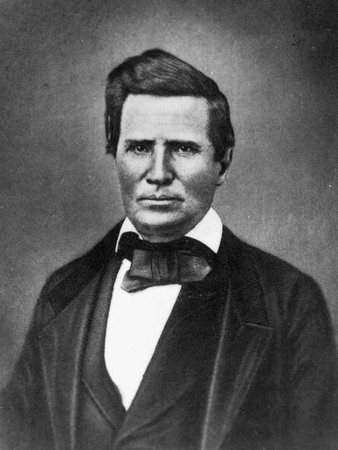19th Century History of Present-Day Loose Park
Introduction
Text-to-speech Audio
Prior to the creation of the Indian Removal Act in 1830, most of the land of what is now Jackson County, Missouri was occupied by Kansa and Osage Tribes. Under President Andrew Jackson's administration, the creation of the Act forced Native Americans to relocate to territories that were designated west of the Missouri border. Because it was furthest west, the newly established town of Westport became a major resource along the western trail routes of the California, the Oregon and the Santa Fe Trails as travelers outfitted their wagons with supplies before setting out on expedition. In 1831, land just south of Westport became occupied by members of the newly founded Church of Jesus Christ of Latter-Day Saints. Successful hatter from Ohio, Edward Partridge (1793-1840) became the first Bishop and was chosen to accompany founder Joseph Smith to establish the holy land of Zion in Missouri. Partridge left his merchandise and family, and purchased land in Jackson County, in which a portion would later become Loose Park.
Images
Alexander Doniphan was the second owner of the land Loose Park now occupies

Backstory and Context
Text-to-speech Audio
During the same time, a new scholar of law Alexander Doniphan (1808-1887) departed Kentucky in search of greater opportunity. He settled in Lexington, Missouri and quickly made a reputation as a skilled defense attorney. In 1833, he moved to Liberty, Missouri and joined the local militia company called the Liberty Blues. Worries began to grow amongst locals that Mormons would soon outnumber non-Mormons, and efforts to force them out of Jackson County began. Doniphan was hired by the church members for representation; he believed in fairness, was devoted to the rule of law, and insisted Mormons were entitled to the same constitutional rights. However, he was unsuccessful in his defense, leading to their departure in 1833.
Partridge, Smith, and the other members of LDS moved north to Clay County, but speculation of their presence continued to grow. In 1836, Doniphan was elected to the Missouri State House of Representatives as a member of the Whig Party and introduced legislation that organized a county exclusively as a safe haven for Mormons - Caldwell County. By 1838, the militia arrested and imprisoned dozens of Mormons, including Smith and Partridge, with accusations of treason, murder, burglary, arson, robbery, and larceny. As a Brigadier to the militia, Doniphan helped negotiate the surrender of Joseph Smith while others escaped during a prison transfer. He was then ordered to execute the men by firing squad but refused and proclaimed their rights shall not be hindered. As partial payment for his counsel, Doniphan was granted the deed for Partridge's land in Jackson County.
In 1840, Doniphan sold the land to two men; Johnston Lykins, a doctor of medicine, Baptist missionary of Shawnee Indians, and later the second mayor of Kansas City, purchased a portion in the northwest corner, and Westport farmer William Matney bought 212 acres. After years of family dispute following Matney’s death in 1854, distant cousin and son-in-law William Matney Jr. was awarded his land in 1857 but sold it the following year to Colonel William Bent.
William W. Bent (1809-1869) was best known for the establishment of Bent's Fort in the Colorado Territory in 1833. As a major stop along the Mountain Route of the Santa Fe Trail, Bent virtually monopolized trade with American Indians throughout the southern Black Hills. Each spring, 20 to 30 wagons would travel east to Westport and St. Louis with livestock and the goods collected through the summer for trade, and returned in the fall with supplies for winter. Around 1850 Bent abandoned his fort and erected a new post in 1853, but later sold it to the Army. He then built a stockade and became a freighter for the government, and in 1858 purchased Matney’s land in Jackson County.
One of the most notable events on this land was the Battle of Westport during the Civil War. After a two-hour artillery engagement on the third day of battle, October 23, 1864, Confederate soldiers retreated, which is regarded as turning point in the war and the end of Confederate threat in the west.
After Bent’s death in 1869, his widow ran the estate before selling it in 1871. Seth Ward (1820-1903) was a successful trader and was the official Sutler of Fort Laramie, Wyoming, one of the busiest posts on the Oregon Trail. He purchased the 212-acre plot of land in 1871 in his wife’s name, Mary F. Ward, and years later acquired 180 more acres to the south. He incorporated a previously-built small brick house into a mansion and in 1897, leased 110 acres to the newly established Kansas City Country Club, the first of its kind, for a nine-hole golf course for $1 per year. Ward bought into a bank established by his brother in-laws and became president, but in 1878 when the bank failed, Ward retired to the farm. In 1902, he created Ward Investment Company but died the following year.
The city annexed more land in 1909, moving its boundaries further south. Mary Ward and her son Hugh, partnered with J.C. Nichols to sell their acreage for residential development, while the land of the Country Club remained undeveloped. In 1926, Ella Loose bought a 74-acre plot of land of the Ward estate to create a park in honor of husband Jacob, who passed away in 1923.
